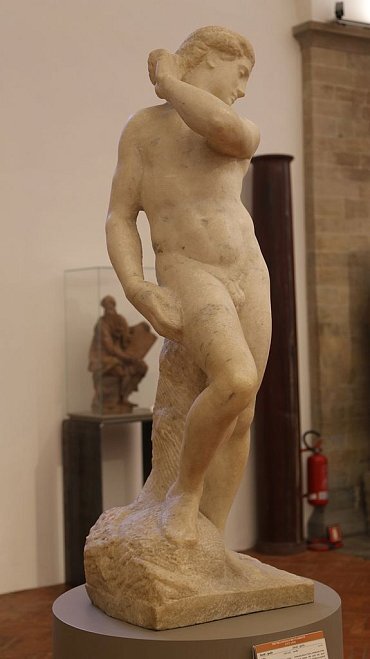Michelangelo's works at the Museum of the Bargello

The Bargello Museum in Florence hosts important masterpieces of the most famous Renaissance sculptor. We're talking about Michelangelo Buonarroti, of course, who has his own hall at the museum.
In particular, the museum contains some early works of the master: the Bacchus (1497) and the Tondo Pitti (1504). The Bacchus is the first sculpture carved by Michelangelo when he was at 22 years old. It is one of the rare artist profane subjects, a figure of drunk faltering, almost in balance on one foot, modeled after the classic sculptures. It is a marble sculpture commissioned by Cardinal Raffaele Riario. The work was later rejected by the Cardinal and bought by Jacopo Galli, who placed it in the courtyard of his house. The statue evokes the pagan myth of Bacchus, represented here as a "young drunk god" who staggers claiming a trophy while behind him a small satyr, sitting on a log, slyly take advantage of his drunknness to taste the grapes he holds with his left hand.The Bacchus is made in a natural way, like a child who comes forward with uncertainty because of his drunkenness.
With the Tondo Pittiwe switch to a religious subject, the bas-relief, partly unfinished, represents in fact the Madonna and Child with the Young Saint John. The tondo dates back to the years when Michelangelo was carving the David, finding the time to devote also to a profitable private commission. This work was in fact carried out for Bartolomeo Pitti. In 1823 it was then bought by the Florentine Galleries and placed at the Uffizi, and only finally, in 1873, it found its final seat at the Museum of the Bargello. The tondo represents Mary, who, with an open book on her knees, looks away in the distance like meditating on the fate of his son just read in the prophecies of the Holy Scriptures.The child leans on her in a lively contrast, on the background it appears St. John. The fulcrum of the entire composition is Mary who seems to bend over to get the best in the round space, however, giving the impression of wanting to get out of it.
Another work by Michelangelo kept in the Museum of the Bargello is the David-Apollo, dating from 1530-32, carved for Baccio Valori, and then passed into the collection of Cosimo I. The work was partially completed in the back, and it shows a rough surface, the famous "unfinished" typical of Michelangelo. The statue incompleteness does not allow to identify exactly the subject. For Vasari it is an Apollo in the act of taking an arrow from the quiver, while in the inventory of Cosimo I it is remembered as a David, hence the double name assigned to the statue. According to some sources, it could be that Michelangelo had begun the project with the intention to create a statue of David but then, in the process, has changed his mind and transformed him into an Apollo. The work depicts a completely naked young man, in a complex twist. In the face there's a feeling as melancholy or perhaps even regret.
The last work is Brutus, a bust of 1539 made against a request by Cardinal Niccolò Ridolfi. The decision to carve a Brutus, murderess of Julius Caesar, was linked to the political events of those years. Lorenzino de 'Medici in 1537 had in fact killed Alessandro de' Medici, thus making a significant contribution to the liberation from the Medici supremacy and allowing the birth of a new government. Stylistically the work is very reminiscent of the ancient statues. The Bruto recalls, at the same time, other works by Michelangelo, such as the David. Looking at the statue you can see the his concentrated and nervous expression. All the facial detail and the excellent drapery of Bruto's garment make this one of the most popular works by Michelangelo.











